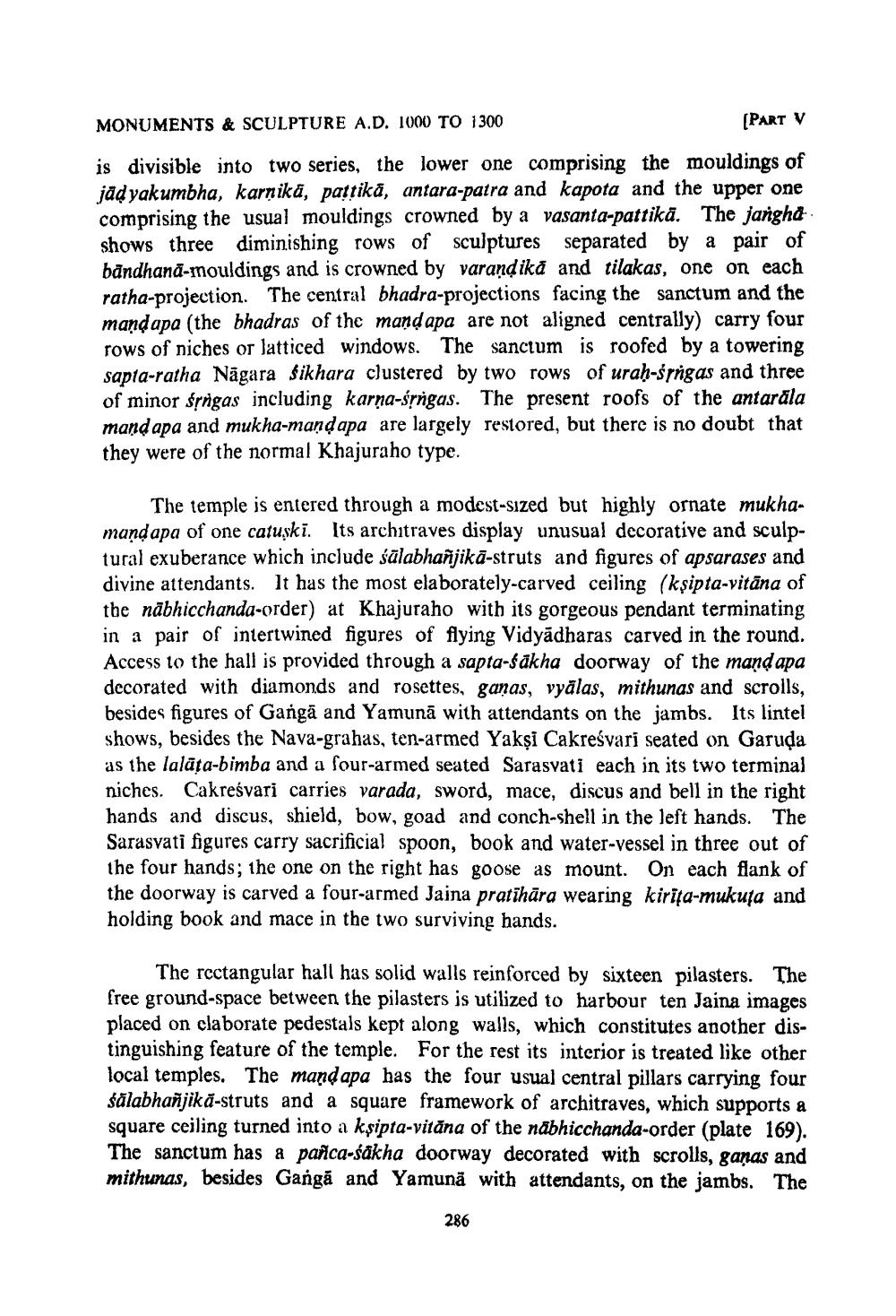________________
MONUMENTS & SCULPTURE A.D. 1000 TO 1300
[PART V
is divisible into two series, the lower one comprising the mouldings of jadyakumbha, karnikā, paṭṭikā, antara-patra and kapota and the upper one comprising the usual mouldings crowned by a vasanta-pattikā. The jangha shows three diminishing rows of sculptures separated by a pair of bandhana-mouldings and is crowned by varandika and tilakas, one on each ratha-projection. The central bhadra-projections facing the sanctum and the mandapa (the bhadras of the maṇḍ apa are not aligned centrally) carry four rows of niches or latticed windows. The sanctum is roofed by a towering sapta-ratha Nagara Sikhara clustered by two rows of urah-srngas and three of minor syngas including karna-śṛngas. The present roofs of the antarala mand apa and mukha-mandapa are largely restored, but there is no doubt that they were of the normal Khajuraho type.
The temple is entered through a modest-sized but highly ornate mukhamandapa of one catuski. Its architraves display unusual decorative and sculptural exuberance which include salabhanjika-struts and figures of apsarases and divine attendants. It has the most elaborately-carved ceiling (kşipta-vitāna of the nabhicchanda-order) at Khajuraho with its gorgeous pendant terminating in a pair of intertwined figures of flying Vidyadharas carved in the round. Access to the hall is provided through a sapta-sakha doorway of the mandapa decorated with diamonds and rosettes, ganas, vyālas, mithunas and scrolls, besides figures of Ganga and Yamuna with attendants on the jambs. Its lintel shows, besides the Nava-grahas, ten-armed Yakşi Cakreśvari seated on Garuda as the lalata-bimba and a four-armed seated Sarasvati each in its two terminal niches. Cakreśvari carries varada, sword, mace, discus and bell in the right hands and discus, shield, bow, goad and conch-shell in the left hands. The Sarasvati figures carry sacrificial spoon, book and water-vessel in three out of the four hands; the one on the right has goose as mount. On each flank of the doorway is carved a four-armed Jaina pratihāra wearing kirita-mukuja and holding book and mace in the two surviving hands.
The rectangular hall has solid walls reinforced by sixteen pilasters. The free ground-space between the pilasters is utilized to harbour ten Jaina images placed on claborate pedestals kept along walls, which constitutes another distinguishing feature of the temple. For the rest its interior is treated like other local temples. The mandapa has the four usual central pillars carrying four salabhanjikä-struts and a square framework of architraves, which supports a square ceiling turned into a kşipta-vitana of the nabhicchanda-order (plate 169). The sanctum has a pañca-sakha doorway decorated with scrolls, ganas and mithunas, besides Ganga and Yamuna with attendants, on the jambs. The
286




